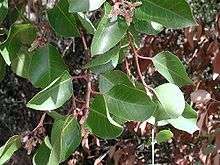Rhus ovata
| Rhus ovata | |
|---|---|
 | |
| Scientific classification | |
| Kingdom: | Plantae |
| (unranked): | Angiosperms |
| (unranked): | Eudicots |
| (unranked): | Rosids |
| Order: | Sapindales |
| Family: | Anacardiaceae |
| Genus: | Rhus |
| Species: | R. ovata |
| Binomial name | |
| Rhus ovata S.Watson | |
 | |
| Natural range | |
Rhus ovata, also known as sugar sumac[1] or sugar bush, is an evergreen shrub to small tree that grows in chaparral in dry canyons and south-facing slopes below 1300 m in Southern California, Arizona and Baja California.
Distribution
The main Rhus ovata population range is from the central and Pacific region Baja California north into Pacific coastal Southern California, and also in the central Arizona region of the Mogollon Rim. Rhus ovata often hybridizes with Rhus integrifolia.
Description
Rhus ovata size ranges from 2–10 m (6.6–32.8 ft), tall and it has a rounded appearance. The twigs are thick and reddish in color. Its foliage consists of dark green, leathery, ovate leaves that are folded along the midrib. The leaf arrangement is alternate.
Its inflorescences which occur at the ends of branches consist of small, 5-petaled, flowers that appear to be pink, but upon closer examination actually have white to pink petals with red sepals. Additionally, the flowers may be either bisexual or pistillate. The fruit is a reddish, sticky drupe, and is small, about 6 – 8 mm in diameter.
Ecology
The fruit and flowers are also popular with birds and butterflies and the plant itself provides good habitat for birds.
Uses
Cultivation
Rhus ovata prefers well-drained soil in a sunny location, with little water once established, being a very drought-tolerant plant. It does not respond to formal boxed pruning well; however, as needed for wildfire fuel reduction or rejuvenation, occasional autumnal cutting, down to above the base crown, is done for new basal sprouting.
Fruit
The fruit of Rhus ovata can be used to make a drink similar to lemonade.
See also
- California chaparral and woodlands - (ecoregion)
- California coastal sage and chaparral - subecoregion
- Coastal sage scrub - (plant association)
- California montane chaparral and woodlands - subecoregion
References
- ↑ "Rhus ovata". Natural Resources Conservation Service PLANTS Database. USDA. Retrieved 21 October 2015.
- Saunders, Charles Francis. Edible and Useful Wild Plants, Dover Publications Inc., New York, 1976.
- Schmidt, Marjorie G. Growing California Native Plants, University of California Press, 1980.
External links
- Jepson Flora Project - Rhus ovata
- USDA Plants Profile: Rhus ovata
- Rhus ovata - Photo Gallery
- Sonoran Desert Field Guide